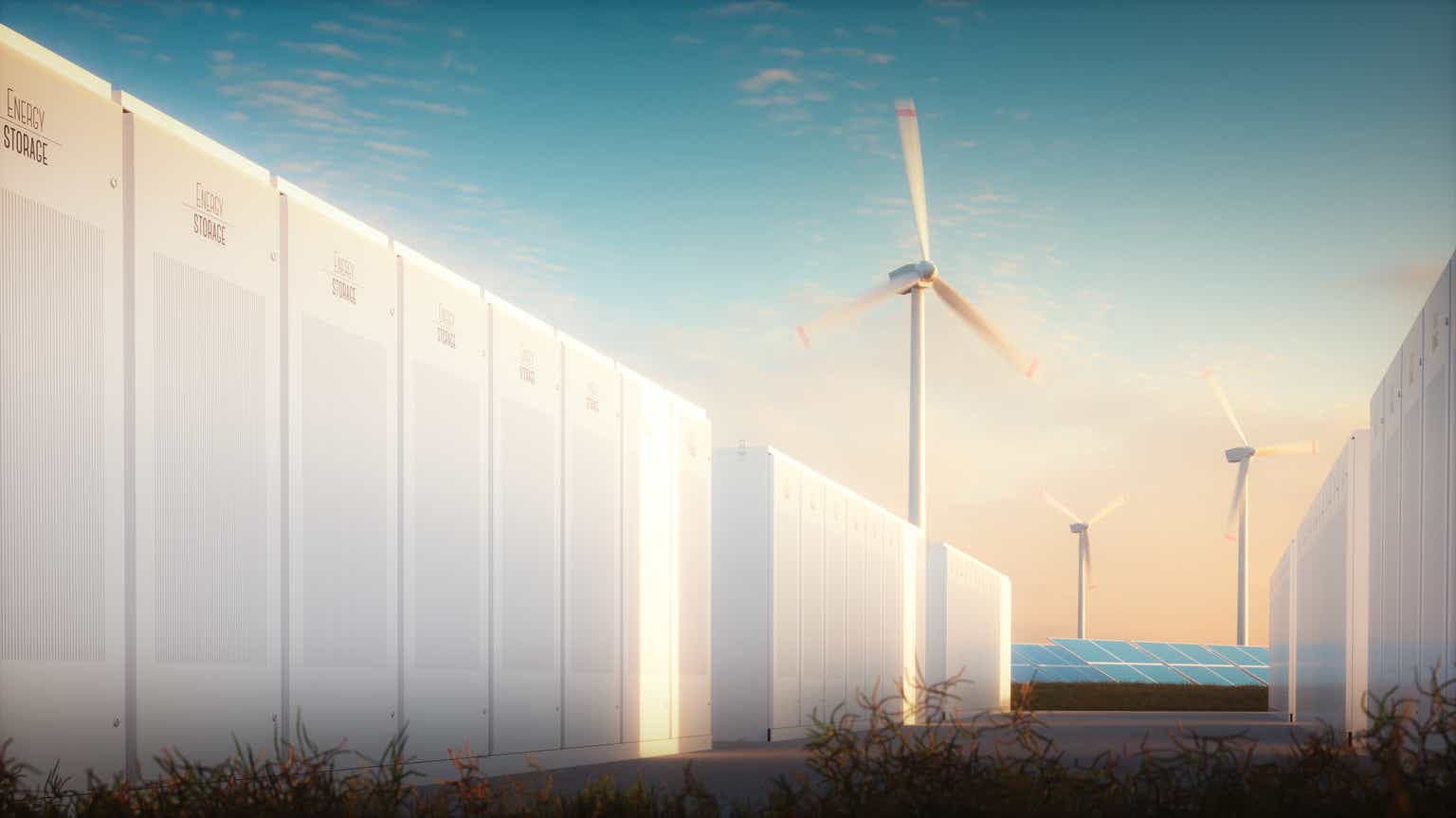The concept of saving energy from renewable sources. 3d illustration of a modern battery system with a background of solar wind power plants in a warm evening light.
The news
On June 15, 2023 LEAG and ESS Tech (NYSE:GWH) announced a major grid scale storage battery as part of their green energy project at LEAG’s Boxberg, Germany power plant. Ultimately this project may include 2-3GWH of capacity. The first phase of 50 MW/500 MWh, utilizing ESS Tech’s iron flow battery technology, is slated to be online by 2027. LEAG has already added a page to their website dedicated to this new battery. May that sort of timely and easily accessible disclosure rub off on ESS.
Investment Thesis
ESS has been plagued by single sales to a few users each quarter. Only one customer has re-ordered and the sale of multiple units to Australia has been plagued by transit, customs, commissioning, and a poorly performing in country partner. With about $115 million of cash and no debt the company has had a $20+ million per quarter cash burn rate. This all had me at a “hold” but I am now moving to a “buy”.
ESS has fully automated its factory in Wilsonville, OR and has sufficient capacity to build this new battery by its due date in 2027. Full details of the contract won’t be known until it is executed in the 3Q but this order, by a sophisticated customer already operating a grid scale battery, adds a stamp of legitimacy. It should add a base load to ESS’s plant, evening out production and driving it toward profitability.
This article isn’t intended to be a financial or peer review. Some of that is available in my previous articles and I would steer interested readers to a great current comparison of ESS to two peers, “Flow Batteries: Progress at ESS, Lockheed Martin and RedFlow” by @keith williams.
Other big batteries
The first phase of this project, at 50 MW/500 MWh, is a minnow among whales. Wikipedia details 57 grid scale batteries ranging as high as 510MW/3,005 MWh. One project it looks like Wikipedia missed is LEAG’s “BigBattery” (excuse the German in the video link) at their Schwarze Pumpe site which is 53MW/50 MWh. The fact that ESS’s partner LEAG already has experience with a grid scale battery is a major positive, and nearly unique in the small number of ESS customers announced to date. But this is a very different battery, than the existing “BigBattery” as discussed below.
If the full 2-3GW battery mentioned in the press release is ever built, ESS would be swimming with the whales, near the front of the pod.
What is the revenue implication?
The latest disclosed price for a 400kwh ESS Energy Warehouse is $189,000 [3Q 2022 earnings call]. That works out to a peppy $472.50/kwh. Projections abound for where that price is headed with the company’s own Alan Greenshields eventual estimate of $20/kwh. I think a more reasonable estimate for this 3.5 year deliverable project is the company’s quoted estimate of $200/kwh by 2025. Arguing for a muted reduction is the company’s huge annual 800MWh stated capacity. This battery’s 500MWh size must be weighed against the 2.8GWh of capacity the company will have cumulatively through the 2027 commissioning date.
So $200/kwh is $100 million in revenue for the first phase of this ESS/LEAG battery. I’m not going to hazard a guess at profitability since the company has been silent on their cost curve and profitability estimates.
What is the existing “BigBattery” at LEAG’s Schwarze Pumpe site?
This is a Lithium Ion battery with technology from LG Chem (OTCPK:LGCLF).
LEAG’s press contact was kind enough to provide an overhead of the site, since Google’s satellite view is apparently several years out of date:
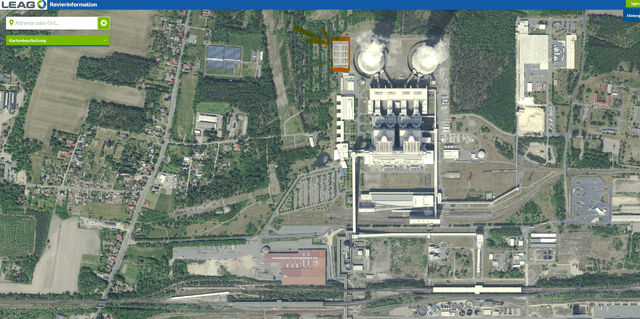
BigBattery Site at Schwarze Pumpe (LEAG.de)
The existing site is 110 x 62 meters (1.69 acres) to the left of the cooling towers, highlighted in red. (The new battery site at the Boxberg plant is about 30km away.) I believe this system is about 26 40′ shipping containers split between batteries and switch gear/inverters. The first phase of this new ESS/LEAG project will likely not be in shipping containers. It has 10x the capacity in MWh, which will take a lot more space than the existing battery– iron flow batteries are big and a lot less dense than LiOn. (My readers will appreciate that I love those overhead views of ESS’s farflung operations.) A sanity check on the size of this installation is 74MWh/acre or 6.75 acres for this new battery. Fortunately these old East German plants have massive amounts of space with more in the nearby open top coal mines.
The existing “BigBattery” is apparently a short term balancing battery as the following schematic from LEAG’s website indicates:
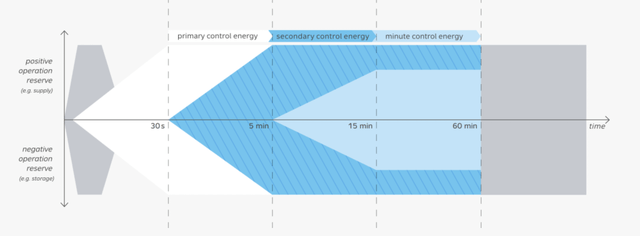
Balancing Power (LEAG.de)
This explanatory text follows the schematic:
The different types of balancing power differ in their provision time and duration. For example, primary balancing power must be fully available within 30 seconds and be usable for a duration of five minutes. Secondary balancing power follows within five minutes and the minute reserve within 15 minutes.
Today, most of this balancing power comes from conventional power plants, as it must be absolutely reliably available regardless of wind and sun. Alternative solutions are needed here in the course of the energy transition. Battery storage systems such as BigBatteries are a key technology.
Why did LEAG select ESS for this next phase? I believe there are 3 main reasons: better safety of this chemistry, cost, and duration.
On safety: Despite the tendency to build walls to separate Germany, I don’t think the following picture of the installation at the BigBattery site is about that:
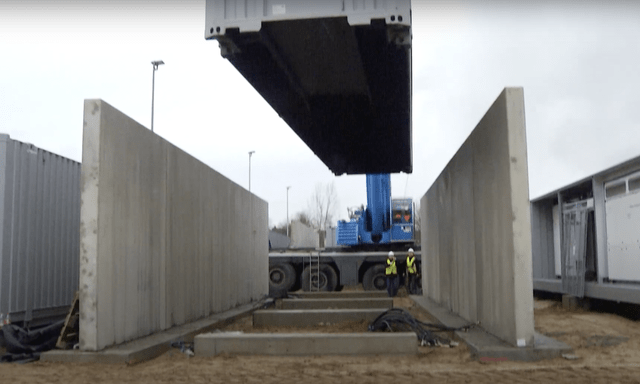
Firewalls (youtube)
instead, I believe those are blast/firewalls in case the LiON battery malfunctions and catches fire, as have several grid batteries of that chemistry. ESS’s iron flow battery in inherently inflammable, or far less flammable, with its salt water electrolyte.
On cost: While the cost section above details a high cost of acquisition today, the cost over the lifetime of the battery is quite favorable compared to competing technologies. The company presented this graphic in one of its SPAC merger prospectuses:
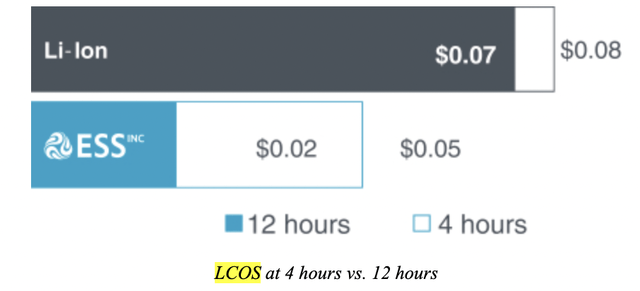
LCOS (Company Prospectus 9/14/21)
LCOS (lifetime levelized cost of storage) is the cost of kilowatt hours in and out over the life of the battery.
On duration: While it’s a great oversimplification, one can divide the MW into Mwh capacity to get some indication of duration. For instance the 50 Megawatt hours of the existing BigBattery could be drawn down in about an hour at its maximum 53 megaWatt rate. That’s sufficient for handling momentary demand spikes, voltage dips and excursions away from the 50Hz frequency used in Europe.
Continuing with this oversimplification, the ESS/LEAG 500 Megawatt Hour battery could be drawn down in 10 hours at the maximum 50 Megawatt rate. That duration allows the afternoon sun captured by photovoltaic to handle some of the evening demand peak, idle through the night, and handle some of the morning rush hour demand peak. The existing battery balances abnormalities on the grid. The new ESS/LEAG battery balances the renewables produced by sun and wind by storing that energy to be used in normal daily peaks. ESS has tried to talk about their duration feature vs. lithium ion but this will be a great example of how long duration and short duration batteries can work well together.
What are some of the remaining questions?
My biggest question at the moment remains the company’s poor selection, management, and disclosure regarding its Australian partner ESI Asia. This is not an auspicious moment to go to a new continent and begin selecting, managing, and disclosing the doings of a slew of new partners.
On this specific project SA comment threads have generated a number of questions. Thanks to @WhitneyB for his questions:
– is there a deposit or any other commitment on this order?
– will these fuel cell stacks be built in Wilsonville since we apparently have more than enough capacity?
– Are we exclusive to the Germans for storage?
– Did we pledge not to compete in their service area and not pursue other German customers?
– What’s the revenue decrement and profit increment/decrement on building larger systems like this?
– Are we responsible for anything beyond that battery? Curious since classic Balance of System and integration issues appear at the crux of our revenue recognition issues.
– what is the duration of this battery?
– What are milestones that have to be reached in order that progress payments be released?
-Is this a matter of delivering a certain number of units of an existing design, and if so, when is the first shipment due?
-If this contract involves the construction of a large, unitary facility, who is responsible for the aspects of construction that are outside of ESS area of expertise, and what will be the impact of any delays occasioned by other contractors?
-Is a performance bond required of ESS, and has it been posted?
-Who or what entity will be in charge of certifying adequate performance has been achieved for ESS to receive a progress payment?
-What are the contractual terms defining how and when to resolve disputes over timely performance?
-How long does ESS have to cure any defects upon receipt of notice?
-What happens to the deliverables if the project is halted after partial performance?
-What method of dispute resolution is built into the contract?
-What country’s laws apply, and in what court would the parties appear in the event a lawsuit became necessary?
-To what extent do those laws permit ESS to apply for and receive an order allowing them to enter the premises and retrieve their equipment if the German buyer doesn’t perform?
-How long is the dispute resolution process anticipated to take in that venue?
-Which party is potentially liable for the other’s attorney fees and costs?
-To what extent is an insurance company obligated to provide a defense if ESS is sued?
-To what extent is ESS requires to pay a deductible or a self-insured retention payment before the duty to defend and indemnify is triggered?
-Have there been any communications to date raising questions or issues regarding ESS’ performance to date?
-Under what circumstances is the contract voidable, either by its terms or under applicable law?
-based on the contract… what’s the worst thing that could happen here, and what could happen between the parties after that?
This level of detail is way beyond what ESS has provided before. I grade their transparency on contractual matters, even when they don’t give up sensitive information, as very poor. Hopefully we hear a lot more response to these concerns when the contract is signed in the 3Q as the press release promises.
Conclusions
Analysts, shareholders, and I have been awaiting some sign of validation that this promising sounding technology really works. This $100 million order from a customer well experienced in grid scale batteries provides that. This puts a huge load on ESS’s automated factory. The 50MW/500MWh battery being ordered, to be on line by 2027, would require 70 units per quarter if it were to be supplied in the 400kw Energy Warehouse form factor the company has been selling. This is a welcome uptick for a company that built 9 EW units in the last quarter. But it will likely be supplied with a longer duration and in the Energy Center 3MW form factor which was talked about at the time of the SPAC merger. And hopefully that larger form factor will drive ESS towards profitability and showcase an offering other utilities might prefer.
Adoption of this new iron flow battery technology is a bit like the progression from Visicalc to Lotus123 to Microsoft Excel. I was a diehard user of Visicalc and the press told me they had an unassailable position. Then I was a diehard user of Lotus 123; same unassailable position. And now I’m an Excel user. As the industry articles and the Wikipedia list of grid scale storage plants illustrate, the incumbent technologies are Molten Salts, compressed air, pumped storage and lithium. And the press talks about their unassailable position. Flow batteries, and ESS’s iron flow batteries in particular, are late to the party and have a mountain to climb in terms of familiarity, and then adoption. This phased approach in East Germany should encourage both.
To date, ESS has been playing softball in the backyard. This deal catapults them into the major leagues. The company’s second largest shareholder, Breakthrough Energy Ventures LLC was founded by Bill Gates. And this well heeled group is mentioned in the press release as some sort of marriage broker between LEAG and ESS. This spotlight, and the potential for this deal, have moved me from a hold to a buy, despite some of my misgivings mentioned here and in previous articles.
Finally, another article is needed to salute LEAG in their cleanup of some of the world’s dirtiest– brown lignite coal– electric production. And ESS should be saluted for forging a path to abundant materials and away from the environmentally unfriendly mining and refining of lithium.
Good luck to longs. I am long once again after two big losses and wash sale holding periods. Hopefully I will make it to periscope and snorkel depth soon.
Read the full article here


